ICND1 – IP Routing 2
[am4show have=’p2;’]
Premium Member: You can test your knowledge with these questions first via this link.
[/am4show]
Note: The ICND1 exam requires candidates to understand basic knowledge of dynamic routing protocols (RIP, EIGRP, OSPF).
Question 1
[am4show have=’p2;’]Refer to the exhibit. Mary is sending an instant message to Robert. The message will be broken into a series of packets that will traverse all network devices. What addresses will populate these packets as they are forwarded from Router1 to Router2?
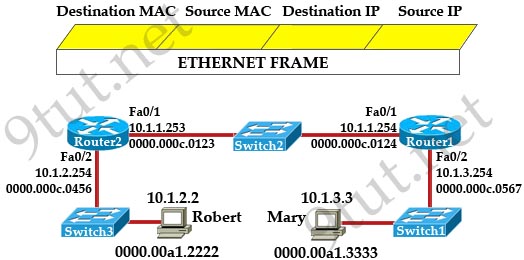
A. 
B.
C.
D.
Answer: A[/am4show]
Explanation
After receiving a packet, the router will keep the source and destination IP addresses (10.1.3.3 and 10.1.2.2, respectively) while change the source MAC address (to the MAC address of its outgoing interface) and the destination MAC address (to the MAC address of the next-hop interface). Therefore when the packet leaves Router1, the source MAC address must be the MAC address of the outgoing interface of Router1 (0000.000c.0124) and the destination MAC address must be the MAC of fa0/1 of R2 (0000.000c.0123).
Question 2
[am4show have=’p2;’]Refer to the exhibit. Which two statements are correct? (Choose two)
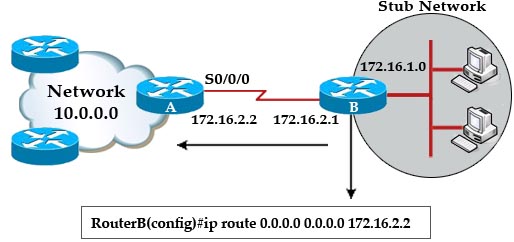
A. This is a default route.
B. Adding the subnet mask is optional for the ip route command.
C. This will allow any host on the 172.16.1.0 network to reach all known destinations beyond RouterA.
D. This command is incorrect, it needs to specify the interface, such as s0/0/0 rather than an IP address.
E. The same command needs to be entered on RouterA so that hosts on the 172.16.1.0 network can reach network 10.0.0.0.
Answer: A C[/am4show]
Explanation
A static route with 0.0.0.0 0.0.0.0 will become a default route. The default route means: “send all traffic to this IP address”. So the default route “ip route 0.0.0.0 0.0.0.0 172.16.2.2” will send all traffic to 172.16.2.2.
Question 3
[am4show have=’p2;’]Refer to the exhibit. Which command would you use to configure a static route on Router1 to network 192.168.202.0/24 with a nondefault administrative distance?
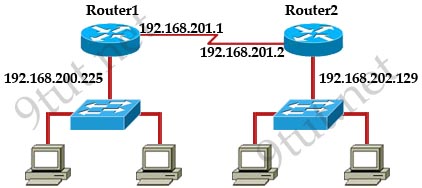
A. router1(config)#ip route 1 192.168.201.1 255.255.255.0 192.168.201.2
B. router1(config)#ip route 192.168.202.0 255.255.255.0 192.168.201.2 1
C. router1(config)#ip route 5 192.168.202.0 255.255.255.0 192.168.201.2
D. router1(config)#ip route 192.168.202.0 255.255.255.0 192.168.201.2 5
Answer: D[/am4show]
Explanation
The Administrative Distance (AD) parameter must be put at the end of the “ip route” command. The default AD is 1.
Question 4
[am4show have=’p2;’]Refer to the exhibit. The output is from a router in a large enterprise. From the output, determine the role of the router.
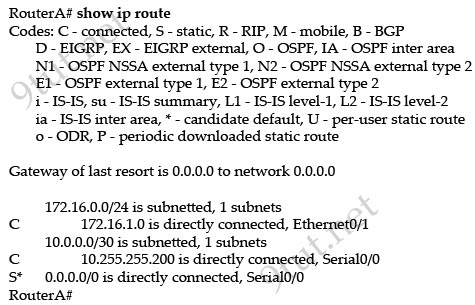
A. A Core router.
B. The HQ Internet gateway router.
C. The WAN router at the central site.
D. Remote stub router at a remote site.
Answer: D[/am4show]
Explanation
This router only have directly connected networks (symbolized by letter “C”) and one default route out of Serial0/0. Maybe this is a stub router with only one connection to the Headquarter or to the Internet.
Question 5
[am4show have=’p2;’]Refer to the exhibit. What is the simplest way to configure routing between the regional office network 10.89.0.0/20 and the corporate network?

A. router1(config)#ip route 10.89.0.0 255.255.240.0 10.89.16.2
B. router2(config)#ip route 10.89.3.0 255.255.0.0 10.89.16.2
C. router1(config)#ip route 10.89.0.0 255.255.240.0 10.89.16.1
D. router2(config)#ip route 0.0.0.0 0.0.0.0 10.89.16.1
Answer: D[/am4show]
Explanation
In this topology, R2 is a stub router with only one connection to the HQ network so the best way to configure routing is to set a static route (default route) to R1.
Question 6
[am4show have=’p2;’]Refer to the exhibit. What must be configured to establish a successful connection from Host A to switch SW-A through router RT-A?

A. VLAN 1 on RT-A
B. IP routing on SW-A
C. default gateway on SW-A
D. crossover cable connecting SW-A and RT-A
Answer: C[/am4show]
Explanation
Host A is in a different subnet of SW-A so SW-A does not know how to send data to host A so it needs to be assigned with a default gateway. The command to assign a default gateway to a switch is “ip default-gateway “. Please notice this command only has effect when “ip routing” is disabled on SW-A.
Question 7
[am4show have=’p2;’]Refer to the exhibit. Which default gateway address should be assigned to HostA?
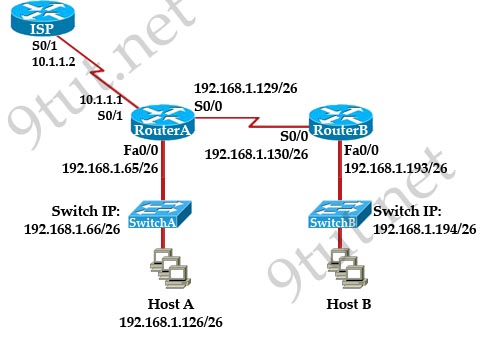
A. 192.168.1.1
B. 192.168.1.65
C. 192.168.1.66
D. 192.168.1.129
E. 10.1.1.1
F. 10.1.1.2
Answer: B[/am4show]
Explanation
The default gateway of Host A should be the connected interface of the router, except host A is connected with a Layer 3 switch. In this case, Switch A is a pure Layer 2 switch and Switch A IP address is just for management purpose.
Question 8
[am4show have=’p2;’]Which value is indicated by the next hop in a routing table?
A. preference of the route source
B. IP address of the remote router for forwarding the packets
C. how the route was learned
D. exit interface IP address for forwarding the packets
Answer: B[/am4show]
Question 9
[am4show have=’p2;’]Which component of a routing table entry represents the subnet mask?
A. routing protocol code
B. prefix
C. metric
D. network mask
Answer: D[/am4show]
Question 10
[am4show have=’p2;’]Which component of the routing table ranks routing protocols according to their preferences?
A. administrative distance
B. next hop
C. metric
D. routing protocol code
Answer: A[/am4show]
Explanation
The administrative distance of each protocol is compared to see if that route is better or not.
Question 11
[am4show have=’p2;’]Which route source code represents the routing protocol with a default administrative distance of 90 in the routing table?
A. S
B. E
C. D
D. R
E. O
Answer: C[/am4show]
Explanation
Letter “D” is used to symbolize for EIGRP (with a default AD of 90). Letter “E” is not used for EIGRP because it has been used for Exterior Gateway Protocol (EGP) which is a obsolete routing protocol now.


Doesn’t Sw-A in question 6 already have an address assigned to it in the topology?
So then why would it need a default gateway to communicate with Host A?
Sw A in question 6 has an IP address which will be used only for remote management. Hence the need for an default gateway.
Marcel, how do you know the Sw A is being used for only for remote management?
If the switch is NOT a layer 3 device (specifically says no routing) then the IP is just used for management. There is actually another question that asks that specific thing “What does an IP on a switch provide?” The answer is remote management.
If it was a layer 3 switch (which, in my mind I think of a layer 3 switch as a router for purposes like this) then you could setup routing and some other features. Layer 2 is all MAC, the layer 3 address is so you can manage that switch through the SVI interface.
It seems like Question 2 have wrong answer:
Router A still doesn’t know anything about 172.16.1.0 subnet. It must have default route to Router B. So host from subnet 172.16.1.0 can send packet to left side of picture, but they will never receive a reply. Just check it in your GNS3.
debug ip packet on any host in 10.0.0.0 and ping it from any host from subnet 172.16.1.0.
So, on my mind right answers are C and E.
Oh, sorry about my English…
And about answers, a mean the right one: A and E in Question 2.
Now i should get some sleep…
Nope, it cannot be E because you cannot enter THE SAME command on RouterA (it has to have at least a different next hop address – 172.16.2.1 in our case).
@Anonymous
While E is not the correct answer as Val pointed out, you are correct that traffic would not be routed properly, since router A has no knowledge of 172.16.1.0, so traffic would be dropped (or sent to router A’s default route).
Anyone,
I plan on taking exam next week. What other sims/labs did you get besides the OSPF 6 router?
Thanks in Advance!
Q2 is correct, A because it is a default route and C becuase it clearly says This will allow any host on the 172.16.1.0 network to REACH all known destinations beyond RouterA, it does not say the packet will be replied but definetely will reach the destination.
qustion 3 need more explanation why D Not B is it becouse AD defoult 5 or ?
@kammel Q3 is correct with D because the default administrative distance for a static route is 1 and it is clearly asking for a nondefault administrative distance. In this case given the options is 5.
-AD-
Static: 1
EIGRP: 90
OSPF: 110
RIP: 120
It seems like Question 4 needs more explanation, I still do not see why this has to be a Stub Router and not an HQ or WAN?
Question 5 – Can someone explain me. Becuase I understand need to have both side to talk and that why I think answer
A. router1(config)#ip route 10.89.0.0 255.255.240.0 10.89.16.2
B. router2(config)#ip route 10.89.3.0 255.255.0.0 10.89.16.2
Because router 1 also have to have a route to send packet back to other network.
May be I am wrong. I understand that both router need the routing information regarding the networks.
Harsh
For question 2 I donot think we need to enter
E. The same command needs to be entered on RouterA so that hosts on the 172.16.1.0 network can reach network 10.0.0.0.
Becuase this network is on RouterB and this router needed to know where to go if 172.16.1.0 network trys to go to any other network beside 172.16.1.0.
Shyamal
Question 4 is also confusing, isn’t 0.0.0.0 default route if no other routes exist?
can someone explain why question 4 is answer D? a quick google search says Remote stub router is an EIGRP concept also covered in ICND2, so NOT an ICND1 topic, i believe that answer should be B
Q1, please advise me the packet is going out from R1 output so it will use its MAC add of fa0/1 then destination MAC add. should be the switch input port actually this should be replaced with hub not switch because each port in switch own a different MAC add. kindly 9TUT correct me if I am mistake, then when the packet leave this switch it will leave from different port which means different MAC source add. all the way to fa0/1 of R2.
Anyone agree ??????
Passed my 100-101 exam today and question 2,3,6 were there.. all the best
Mustafa, the switch input port is looking at the output of R1, therefore R1 MAC address is learned by that switch port (directly connected). Same with R2 on the other side. So if R1 Sends with MAC of R2 SW knows it is on the other (directly connected) port and sends it out…. see what I mean.
Took test today. Questions 1, 2, 3, 5, 7 were there.
On Q5, the quad 0 quad 0 route is definitely the best answer, but why would the static route not be pointing to the ip of the exit interface on R2 (10.89.16.2)?
D. router2(config)#ip route 0.0.0.0 0.0.0.0 10.89.16.1
can somebody explain to me the question 6?
I mean the question three,, since the administrative distance is 1 why is the last option selected as the right one. it’s a bit confusing
Question 3: Please check the answer
Your explanation and your answer don’t match. I think the answer is B
“The Administrative Distance (AD) parameter must be put at the end of the “ip route” command. The default AD is 1.”
Please share more questions if you took 100-101 recently. I checked all these answers are right.
hi, in question 5, to establish connection between regional office and corporate, answer A must be done to or not?? i get the answer d, but what about answer a??
John, Many thanks dude 🙂 got it.
People should careful when you are giving the answer for Q3 , read careful “nodefaul ” so it won’t be 1 as we know that AD for statistic is 1. D is correct
People should be careful when you are giving the answer for Q3 , read careful “non default ” so it won’t be 1 as we know that AD for statistic is 1. D is correct
Questions 2-5-7 were in exam on 20/11/2014, more than 45 questions were from 9tut !
Hey @Yahia, How many lab sims have you had? I plan on taking Monday the Janaury 12th.
For Q3 …. why is the answer not B? the AD for a static route is 1. the explanation also states that to be 1?
@ Ben You need to carefully read these because skimming questions will drop your score quickly when you try to take the CCENT or CCNA exam. They will put crafty questions in there that will be right or wrong based on a simple keyword. In the example of Q3:
“…Router1 to network 192.168.202.0/24 with a NONDEFAULT administrative distance?”
9tut makes the point that 1 is the static AD, so knowing that, you should assume that B cannot be correct because it uses the default and not the NONDEFAULT AD that the question asks for.
OK, not understanding Q6, set tge config up in Packet Tracer and i can ping both ways without using the ip default-gateway on SW-A
@DB1968, You can ping between RT n SW , but you can ping between RT n PC..
@DB1968, sry for the wrong comment,
You can ping between RT-A n SW-A , but you can ping between SW-A n HOST-A..
Hi Guys , just passed the ICND1 with 100% score, most questions are the same as 9tut. Thanks 9tut!!
just passed the exam Q3 and Q6 were int the exam
Q 3 in exam
test sorry just wanna check if all these comments are real
kindly send me the latest dumps
So I’m confused with question 6. The answer is to “default gateway on SW-A”. How can you configure a default gateway on a switch unless it was for a management port? Now, maybe if it was reworded to “default gateway TO SW-A” then it would make sense.
guys i got free dumps with nuggets from this following link
wurl. cc/dumps
real?
Q2 A & E
@all: We had to move all the questions and answers out of 9tut. We can only keep the explanation. You can download the questions and answers at: https://mega.co.nz/#!oIdESYbD!yyu33vygrfKPy4rcmcbV6qW2fxINNoTokuDM3CjA_og
Why not option A in Q5?
Is it because we need to look less at the network ip addresses?
Also I am not able to comprehend Q4?
Is it stub router because it has less number of connected routes as it is given,it’s a large enterprise
In question 5 looking at the corporate HQ network is 10.89.3.0/16 a valid network address? With a /16 subnet mask the first 16 bits would be network bits whereas the last 16 would be host bits meaning the network address is 10.89.0.0/16 and broadcast would be 10.89.255.255/16 with all addresses in between being host addresses, 2^16-2 which is 65,534 of them, this is confusing me can someone help out please, cheers
is this damp still valid? please help
hellooooooooooooooooooooooooooooooooooo!!
Dears, is there any question related to ACL in ICND-1 ? please comment
Hi, Q9, why isn’t it prefix?
Hi There,
Why do I see comments here posted before August 2016? That’s before the CCNA version 3.